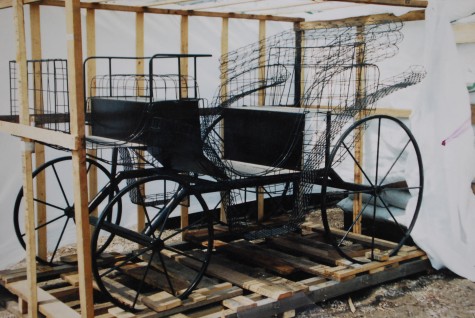 I do not remember what year it was, nor do I remember why, but Rob and I took a trip to New York-it may have been to see the Lucien Freud exhibit at the Met, and eat hot dogs after in Central Park. On the way, we visited every place in Pennsylvania that we thought might have garden ornament or pots. We visited Campania in Quakertown; I was unable to convince them to part with a single piece of their vintage Italian terra cotta. Can you hear me sighing? Meadowbrook Farm, just north of Philadelphia, was a delight to visit. J. Liddon Pennock, noted garden designer and plantsman, willed his 25 acre estate and gardens to the Pennsylvania Horticulture Society in 2004. He kept a small nursery and shop there; I made my first garden ornament purchase ever there. Eventually we ended up at Longwood Gardens-wow. I could write for days about that place, but what enchanted me the most were the topiary ivy sculptures. I bought the book.
I do not remember what year it was, nor do I remember why, but Rob and I took a trip to New York-it may have been to see the Lucien Freud exhibit at the Met, and eat hot dogs after in Central Park. On the way, we visited every place in Pennsylvania that we thought might have garden ornament or pots. We visited Campania in Quakertown; I was unable to convince them to part with a single piece of their vintage Italian terra cotta. Can you hear me sighing? Meadowbrook Farm, just north of Philadelphia, was a delight to visit. J. Liddon Pennock, noted garden designer and plantsman, willed his 25 acre estate and gardens to the Pennsylvania Horticulture Society in 2004. He kept a small nursery and shop there; I made my first garden ornament purchase ever there. Eventually we ended up at Longwood Gardens-wow. I could write for days about that place, but what enchanted me the most were the topiary ivy sculptures. I bought the book.
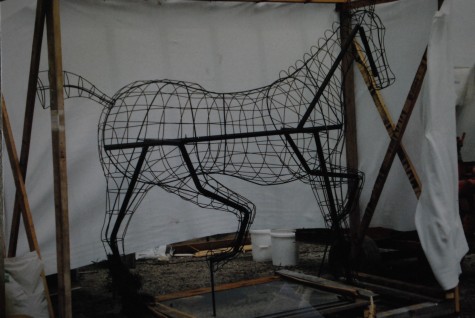 The topiary were not rooted in the ground. The plants were rooted in every surface of the sculptures. The New Topiary: Imaginative Techniques From Longwood was a do it yourself topiary stylist’s dream book come true. Patricia detailed exactly how they were constructed. The steel frames had been made at the Longwood Manufacturing Corporation (no relation to the gardens) and stuffed with plants at the gardens. I could not get these sculptures out of my mind. On the strength of what I saw at Longwood, and what I read in the book, I managed to persuade Grand Hotel to invest in 3 topiary sculptures. A pair of Hackneys, drawing a carriage, as depicted in their logo. They agreed. Some months later, the three steel and wire topiary frames were delivered to me-it was my turn.
The topiary were not rooted in the ground. The plants were rooted in every surface of the sculptures. The New Topiary: Imaginative Techniques From Longwood was a do it yourself topiary stylist’s dream book come true. Patricia detailed exactly how they were constructed. The steel frames had been made at the Longwood Manufacturing Corporation (no relation to the gardens) and stuffed with plants at the gardens. I could not get these sculptures out of my mind. On the strength of what I saw at Longwood, and what I read in the book, I managed to persuade Grand Hotel to invest in 3 topiary sculptures. A pair of Hackneys, drawing a carriage, as depicted in their logo. They agreed. Some months later, the three steel and wire topiary frames were delivered to me-it was my turn.
 This glimpse of the interior of one of the horses helps tell the story of the construction. The topiaries were built in horizontal layers, from the hoofs on up. A layer of the frame was covered in a netting of fishing line. Florists moss was pressed into the fish line. 3 inches of soil came next; individual ivy plants were planted sideways in the breaks between the moss. The body of the horse-much too large a volume to load up with soil. The belly of each horse, a collection of styrofoam peanuts packed loosely into individual plastic baggies. The worst enemy of any topiary built in this way-topiary erosion. The styrofoam interior had to perfectly conform to the available space without any air pockets. We packed and stuffed, and packed again. This photograph was taken when I had to repair a horse that had suffered a too rough a ride back to Mackinac Island in the spring. A large topiary such as this requires a lot of patient work.
This glimpse of the interior of one of the horses helps tell the story of the construction. The topiaries were built in horizontal layers, from the hoofs on up. A layer of the frame was covered in a netting of fishing line. Florists moss was pressed into the fish line. 3 inches of soil came next; individual ivy plants were planted sideways in the breaks between the moss. The body of the horse-much too large a volume to load up with soil. The belly of each horse, a collection of styrofoam peanuts packed loosely into individual plastic baggies. The worst enemy of any topiary built in this way-topiary erosion. The styrofoam interior had to perfectly conform to the available space without any air pockets. We packed and stuffed, and packed again. This photograph was taken when I had to repair a horse that had suffered a too rough a ride back to Mackinac Island in the spring. A large topiary such as this requires a lot of patient work.
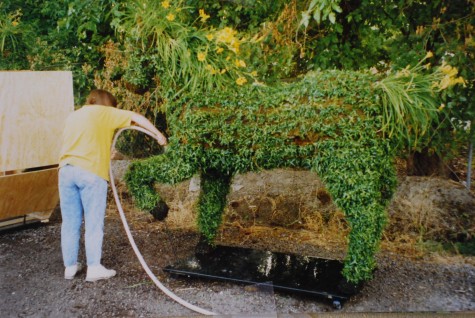 It is easy to see in this picture how the plants were layered horizontally. Finishing the forms took 400 hours-I remember this-and the countless miles of fishline and boxes of moss. Truth be told, it was much more than I bargained for. What it took to make these sculptures road ready-I had no clue; frankly, I grew up with these sculptures. I soaked the sculptures thoroughly before they got packed in their crates. I would get them back in the fall, and winter them in a makeshift greenhouse I had put up for exactly this purpose.
It is easy to see in this picture how the plants were layered horizontally. Finishing the forms took 400 hours-I remember this-and the countless miles of fishline and boxes of moss. Truth be told, it was much more than I bargained for. What it took to make these sculptures road ready-I had no clue; frankly, I grew up with these sculptures. I soaked the sculptures thoroughly before they got packed in their crates. I would get them back in the fall, and winter them in a makeshift greenhouse I had put up for exactly this purpose.
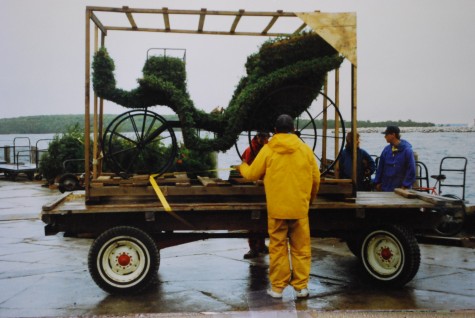 I kept the original crates that the frames came in; Mackinac Island is 340 miles north of where I live. I knew the sculptures would need to travel. A forklift loaded them on a boat, and offloaded them onto a horse drawn wagon for their trip up the hill.
I kept the original crates that the frames came in; Mackinac Island is 340 miles north of where I live. I knew the sculptures would need to travel. A forklift loaded them on a boat, and offloaded them onto a horse drawn wagon for their trip up the hill.
 I planted Stella D’Oro daylilies in the manes and tails. I found glass eyes for the horses from a taxidermy shop. They were finally ready to be placed in the garden.
I planted Stella D’Oro daylilies in the manes and tails. I found glass eyes for the horses from a taxidermy shop. They were finally ready to be placed in the garden.
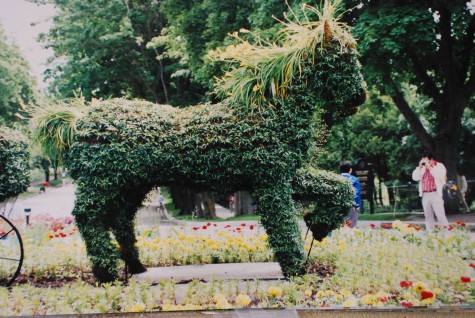 They made quite a statement. This garden had a focus. No matter when I visited, someone was taking a picture. This part felt great. They made the garden so much more friendly, and personal. They invited people to interact with the grounds and gardens.
They made quite a statement. This garden had a focus. No matter when I visited, someone was taking a picture. This part felt great. They made the garden so much more friendly, and personal. They invited people to interact with the grounds and gardens.
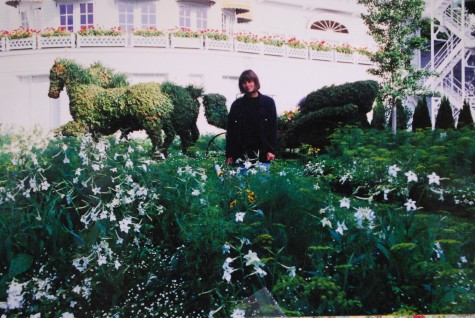 Back then, they were the star attraction in the Triangle garden. Today they reside in a giant lawn space in the tea gardens. This particular year, the tea garden was all white, pale yellow, and dilly. So many dill plants and white nicotiana alata.
Back then, they were the star attraction in the Triangle garden. Today they reside in a giant lawn space in the tea gardens. This particular year, the tea garden was all white, pale yellow, and dilly. So many dill plants and white nicotiana alata.
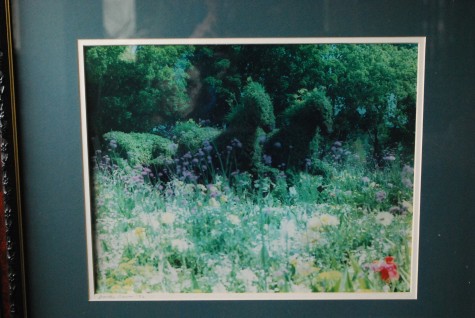
Dorothy Farmer, noted gardener and supervisor of the Cranbrook Gardens auxiliary for so many years took my favorite picture of these sculptures. She framed a copy of her picture, and gave it to me. My photograph of her picture is terrible, but perhaps you can discern a little of what felt like magic to me. The one red canna at the lower right-the odd man out. She asked me about that. Every garden I design has one plant that does not fit. Most times I do it, in acknowledgement of nature. In this garden this particular year, 1996, I planted it for the owners of Grand Hotel. Their interest and committment made a special moment in a garden possible.
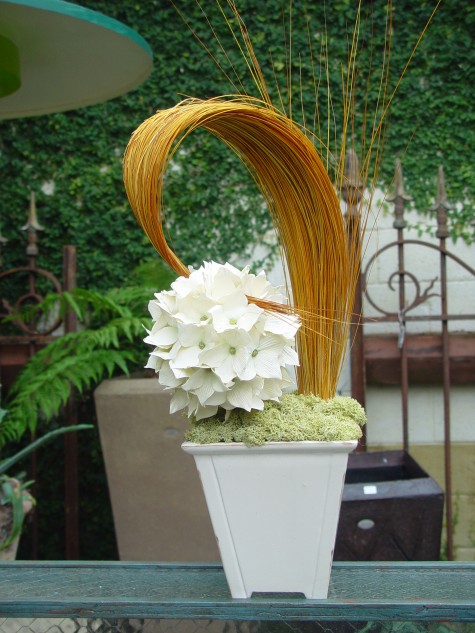 The last two nights the temperatures have been in the high forties and low fifties. Great. I am on the deck last night- in my fleece-having a glass of wine, and contemplating the end of summer. My plants in my pots have gone from gorgeous to grumpy. What to do? The topiary sculptures I make from natural materials in the fall and winter help me face the 6 months we have coming up in Michigan when the garden is dormant. The sculptures are set in dry florist’s foam-I use the John Henry brand. This sculpture, made from a dyed and preserved grass, preserved reindeer moss, and paper dogwood flowers, helps me to bring the beauty of the garden indoors.
The last two nights the temperatures have been in the high forties and low fifties. Great. I am on the deck last night- in my fleece-having a glass of wine, and contemplating the end of summer. My plants in my pots have gone from gorgeous to grumpy. What to do? The topiary sculptures I make from natural materials in the fall and winter help me face the 6 months we have coming up in Michigan when the garden is dormant. The sculptures are set in dry florist’s foam-I use the John Henry brand. This sculpture, made from a dyed and preserved grass, preserved reindeer moss, and paper dogwood flowers, helps me to bring the beauty of the garden indoors.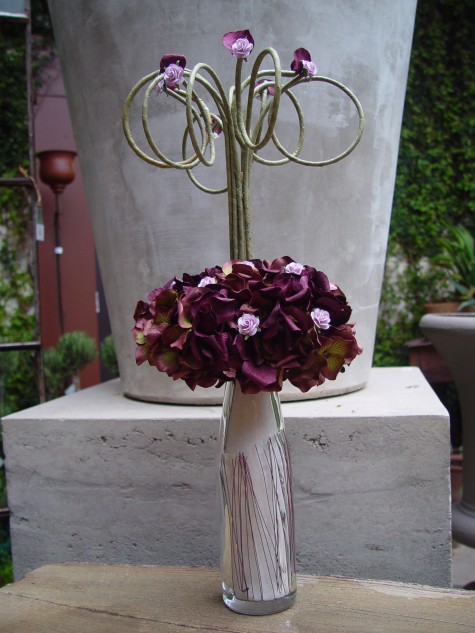 Glass can make great containers for sculptures. This vase by the Parisian artist Vanessa Mittrani is filled with white sand to give it weight. I seal the sand in the vase with a giant blob of hot melt glue, and wedge the foam in the top. Paper hydrangeas, mini-roses, and paper covered wire make for a sassy little something that reminds me of the garden. The purple paper hydrangeas bring out the purple/rust color of the wire in the glass.
Glass can make great containers for sculptures. This vase by the Parisian artist Vanessa Mittrani is filled with white sand to give it weight. I seal the sand in the vase with a giant blob of hot melt glue, and wedge the foam in the top. Paper hydrangeas, mini-roses, and paper covered wire make for a sassy little something that reminds me of the garden. The purple paper hydrangeas bring out the purple/rust color of the wire in the glass. I consider paper a natural material, since it comes from trees. This combination of paper hydrangea petals, and diminuitive paper daisies describe a classic topiary cone shape. The flowery pompom at the top is constructed from individual dried bleached seed pods.
I consider paper a natural material, since it comes from trees. This combination of paper hydrangea petals, and diminuitive paper daisies describe a classic topiary cone shape. The flowery pompom at the top is constructed from individual dried bleached seed pods. Integrifolia is a plant native to Australia, and probably other places as well. The leaves hold tight to the stems for a long time; they also take dye beautifully. This topiary began with individual leaves glued to a spherical form in a pattern reminiscent of an artichoke. As I worked towards the bottom, I reversed the curve on the individual leaves for more volume. The very bottom of the sphere is stuck with short branches just a few inches in length. Preserved reeds bowing out from a twig trunck make for a stem; the base is covered in preserved green seedheads.
Integrifolia is a plant native to Australia, and probably other places as well. The leaves hold tight to the stems for a long time; they also take dye beautifully. This topiary began with individual leaves glued to a spherical form in a pattern reminiscent of an artichoke. As I worked towards the bottom, I reversed the curve on the individual leaves for more volume. The very bottom of the sphere is stuck with short branches just a few inches in length. Preserved reeds bowing out from a twig trunck make for a stem; the base is covered in preserved green seedheads. Paper roses on paper covered wires are a delicate contrast to the heft of dried okra pods.
Paper roses on paper covered wires are a delicate contrast to the heft of dried okra pods.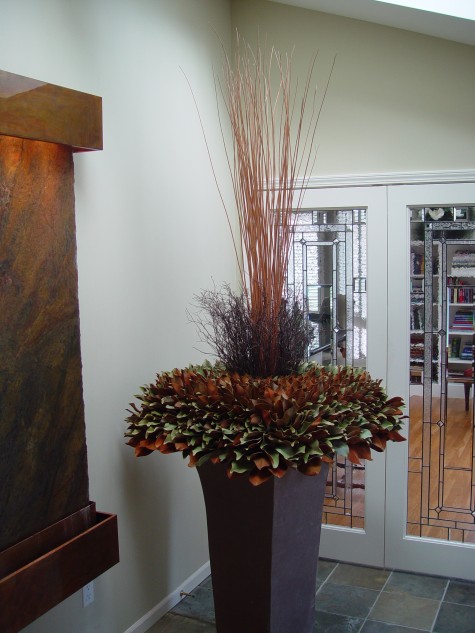 This very large scale sculpture has twigs and short birch branches for a centerpiece; the collar was constructed of fresh southern magnolia leaves. Magnolia dries beautifully, and lasts a long time.
This very large scale sculpture has twigs and short birch branches for a centerpiece; the collar was constructed of fresh southern magnolia leaves. Magnolia dries beautifully, and lasts a long time. The science of preserving natural materials has become quite sophisticated. I for one would never have a house plant. I am happy for the season where I am not a plant caretaker. An object like this demands nothing from me; I just look. The reindeer moss in a color they call spring green is my idea of good color.
The science of preserving natural materials has become quite sophisticated. I for one would never have a house plant. I am happy for the season where I am not a plant caretaker. An object like this demands nothing from me; I just look. The reindeer moss in a color they call spring green is my idea of good color. These steel leaves are by no means a natural material, but they describe one. The base was buttered with ceramic tile mastic, and embedded with tiny shells. The stainless steel wire is difficult to handle; I usually have to get help from a second pair of hands to glue it in.
These steel leaves are by no means a natural material, but they describe one. The base was buttered with ceramic tile mastic, and embedded with tiny shells. The stainless steel wire is difficult to handle; I usually have to get help from a second pair of hands to glue it in. 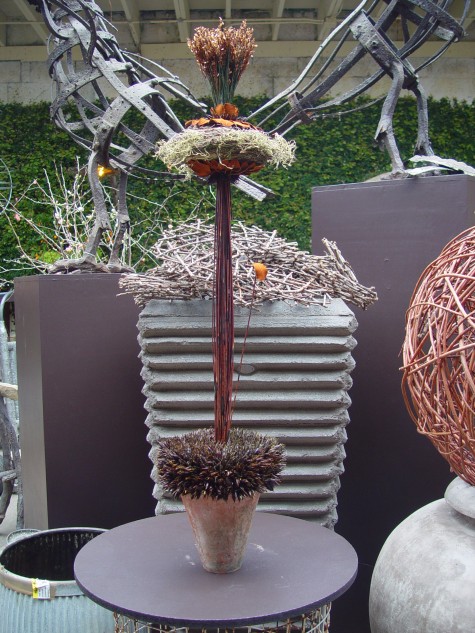 This whimsical topairy makes use of two bird’s nests made of various natural materials, sandwiched together. I buy these long stems covered with hundreds of chocolate seeds. After taking the seeds from the stem, I glued the individual seeds onto this base.
This whimsical topairy makes use of two bird’s nests made of various natural materials, sandwiched together. I buy these long stems covered with hundreds of chocolate seeds. After taking the seeds from the stem, I glued the individual seeds onto this base.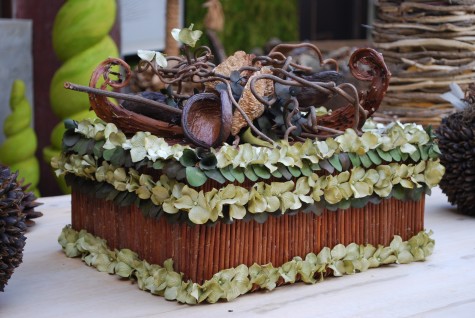 I call this a presentation box. The box itself is a photo box meant to hold 8 x 10 photographs. Should the box never have anything in it, it will still be fun to look at.
I call this a presentation box. The box itself is a photo box meant to hold 8 x 10 photographs. Should the box never have anything in it, it will still be fun to look at. 